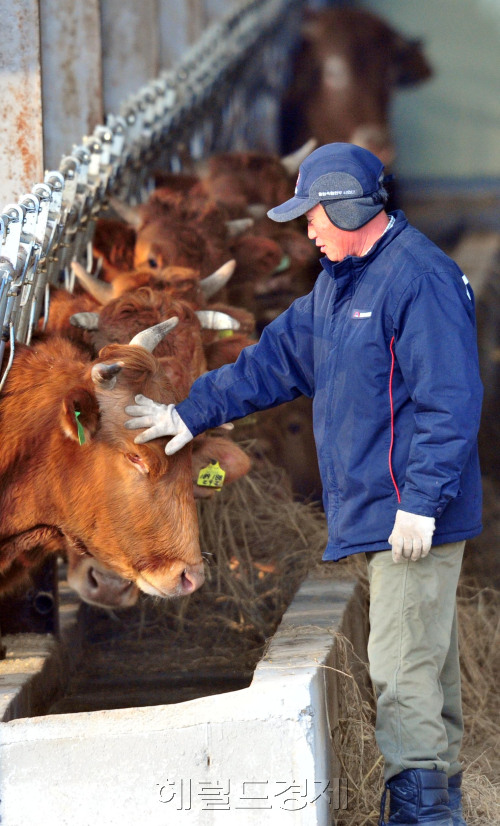Foot-and-mouth disease is feared to spread across the country after three new cases were confirmed including on the northwestern island of Ganghwa on Friday.
Health authorities will begin vaccination in five affected areas Saturday as the epidemic devastated the local livestock industry and forced provincial governments to cancel tourist programs and festivals ahead of the New Year.
The government Friday earmarked 154.1 billon won ($133.4 million) for quarantine and decontamination and support for farmers hit by the disease.
The Cabinet will approve the expenditure plan at a Cabinet meeting slated for next Tuesday, officials said.
During a meeting of top policymakers presided over by Prime Minister Kim Hwang-sik, the government discussed a range of measures to stem the disease including enhancing port quarantine regulations.

Health authorities will begin vaccination in five affected areas Saturday as the epidemic devastated the local livestock industry and forced provincial governments to cancel tourist programs and festivals ahead of the New Year.
The government Friday earmarked 154.1 billon won ($133.4 million) for quarantine and decontamination and support for farmers hit by the disease.
The Cabinet will approve the expenditure plan at a Cabinet meeting slated for next Tuesday, officials said.
During a meeting of top policymakers presided over by Prime Minister Kim Hwang-sik, the government discussed a range of measures to stem the disease including enhancing port quarantine regulations.


The epidemic broke out in the southeastern city of Andong on Nov. 29.
A total of 51 cases were confirmed in some 20 cities and ounties. Authorities have ordered the culling of a record 325,000 livestock so far with estimated losses expected to hover around 400 billion.
The Ministry for Food, Agriculture, Forestry and Fisheries said Friday three additional infections were confirmed on Ganghwa Island off the west coast, Hoengseong in Gangwon Province and Yeongcheon in North Gyeongsang Province.
A large pig production farm with 24,000 animals in Yeongcheon, 344 kilometers southeast of Seoul, tested positive for the disease, it said.
The pigs raised at the production facility are sold to other farms with authorities acknowledging that animals carrying the FMD virus may have been inadvertently sold before a quarantine ring was set up.
The animals were put under close observation only Thursday after some animals started to develop blisters on their snouts, teats and hooves and showed a loss of appetite.
“There is a chance that animals infected with FMD may have been transferred to other farms,” an official, who declined to be identified, said. All animals on the farm and those within a three-kilometer radius are to be culled to prevent the spread of the disease.
Reflecting concern that the disease may continue to spread, a pig farm in adjacent Gyeongju has been quarantined after some animals started showing possible signs of the disease.
An outbreak in Gyeongju could become a serious problem since it is the single largest producer of cattle in the country.
Foot-and-mouth disease affects cloven-hoofed animals such as cattle, pigs, deer, goats and sheep. It is harmless to humans. It is classified as a “List A” disease by the Paris-based World Organization for Animal Health, with countries that report outbreaks barred from exporting meat.
The country was hit by FMD outbreaks in January and April, which cost more than 250 billion won and left nearly 50,000 animals slaughtered.
Korea ordered a halt to pork and beef exports in January when an outbreak was confirmed at Pocheon northeast of Seoul.
Starting Saturday, the government plans to vaccinate 133,000 animals in Andong, where the animal disease was first confirmed on Nov. 29, and nearby Yecheon in North Gyeongsang Province. It said Paju, Yeoncheon and Goyang, all regions in Gyeonggi Province north of Seoul, will be vaccinated.
Some 200 teams made up of 800 personnel will administer the shots. The first vaccination process should take about 10 days with the second shots to be administered a month later to ensure that the animals are properly protected.
Vaccinations will only be given to cattle because they are more vulnerable to the disease, with pigs and other cloven-hoofed animals to be excluded.
(From news reports)










![[Hello India] Hyundai Motor vows to boost 'clean mobility' in India](http://res.heraldm.com/phpwas/restmb_idxmake.php?idx=644&simg=/content/image/2024/04/25/20240425050672_0.jpg&u=)








